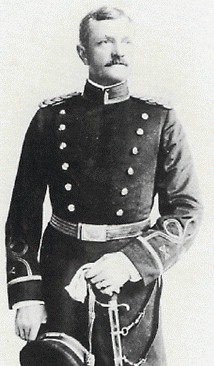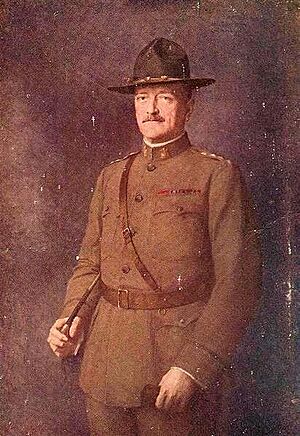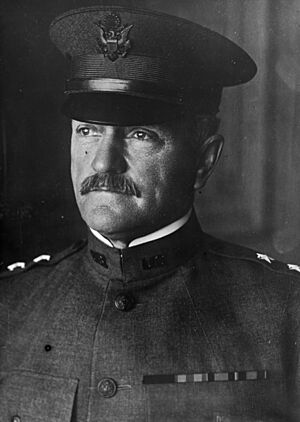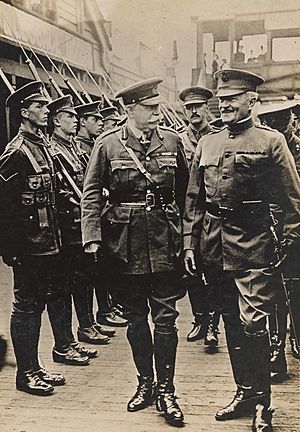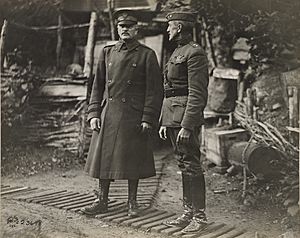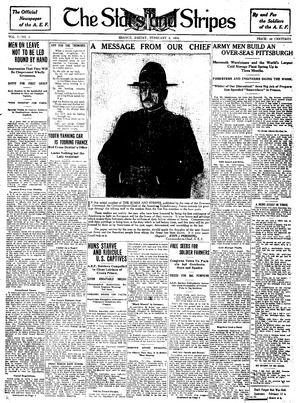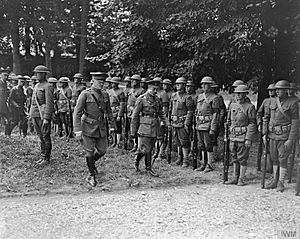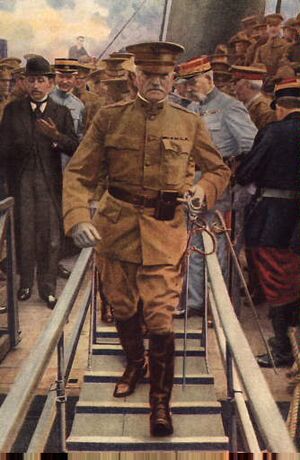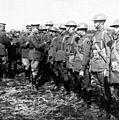John J. Pershing facts for kids
Quick facts for kids
General of the Armies
John J. Pershing
|
|
|---|---|
 |
|
| Birth name | John Joseph Pershing |
| Nickname(s) | "Black Jack" |
| Born | September 13, 1860 Laclede, Missouri, U.S. |
| Died | July 15, 1948 (aged 87) Walter Reed General Hospital Washington, D.C., U.S. |
| Buried |
Arlington National Cemetery, Arlington County, Virginia, U.S.
|
| Allegiance | United States |
| Service/ |
United States Army |
| Years of service | 1886–1924 |
| Rank | General of the Armies |
| Service number | O-1 |
| Unit | Cavalry Branch |
| Commands held | 8th Brigade Mexican Expedition American Expeditionary Force First United States Army Chief of Staff of the United States Army |
| Battles/wars | |
| Awards | Distinguished Service Cross Distinguished Service Medal Silver Star Honorary Knight Grand Cross of the Order of the Bath (United Kingdom) Légion d'honneur (France) |
| Spouse(s) |
|
| Children | 4, with Helen |
| Signature |  |
General of the Armies John Joseph Pershing (September 13, 1860 – July 15, 1948), known as "Black Jack", was a very important United States Army officer. He is most famous for leading the American Expeditionary Forces (AEF) in World War I from 1917 to 1918. He led the AEF to victory.
Pershing also helped train many generals who later led the U.S. Army in World War II. These included George C. Marshall, Dwight D. Eisenhower, Omar Bradley, Lesley J. McNair, George S. Patton, and Douglas MacArthur.
During World War I, Pershing did not want American troops to be mixed into British and French armies. He insisted that the AEF fight as one big unit under his command. However, some American divisions did fight with British forces in battles like Battle of Hamel and at the Hindenburg Line. Pershing also allowed American all-Black units (which were segregated at the time) to fight alongside the French Army.
American soldiers first saw major fighting at Cantigny, Chateau-Thierry, Belleau Wood, and Soissons in 1918. To get troops to France faster, they left heavy equipment behind. They used British and French tanks, artillery, and airplanes. In September 1918, Pershing's First Army won a big victory at St. Mihiel. They pushed back the German Army from an area they had held for three years.
For the Meuse-Argonne Offensive, Pershing moved about 600,000 American soldiers to the Argonne forests. His divisions fought hard for 47 days, alongside the French. This fighting helped lead to Germany asking for an armistice (a ceasefire). Pershing believed the war should continue until all of Germany was occupied. He wanted to make sure German militarism was completely destroyed.
Pershing is the only American to be promoted to General of the Armies during his lifetime. This is the highest rank in the U.S. Army. He chose to keep using four stars as his rank symbol. Later, the five-star General of the Army rank was created in World War II. Pershing's rank was unofficially seen as a six-star general rank. However, he died before Congress could make this official.
Some of Pershing's tactics were criticized by other commanders and historians. He often used costly frontal assaults, even after other Allied armies had stopped using them. This led to many American casualties. He was also criticized for his actions on the day the armistice was signed. Even though he knew the war was ending, he did not tell his commanders to stop new attacks. This resulted in nearly 11,000 casualties (3,500 American) on the last day of the war. This number was even higher than the casualties on D-Day in 1944. Pershing was questioned by Congress later, but he said he followed orders. Congress found no one was at fault.
Contents
Early Life and Education
Pershing was born on a farm near Laclede, Missouri, on September 13, 1860. His father, John Fletcher Pershing, was a farmer and store owner. His mother was Ann Elizabeth Thompson. His family came from Alsace, a region in Europe. John had five siblings who lived to be adults.
During the American Civil War, his father supported the Union side. Pershing went to a special school in Laclede for bright students. After high school in 1878, he taught African American children. He also studied at the State Normal School (now Truman State University) and graduated in 1880.
Two years later, he applied to the United States Military Academy. He did well on the test and was accepted. He later said he applied because the education was free and better than what he could get in rural Missouri. He wasn't initially interested in a military career.
West Point Years
Pershing started as a cadet at West Point in 1882. He quickly showed leadership skills. He became First Corporal, First Sergeant, First Lieutenant, and finally, First Captain. This was the highest rank a cadet could achieve. Pershing also led the honor guard for President Ulysses S. Grant's funeral train in 1885.
He graduated in 1886, ranking 30th in his class of 77. He became a second lieutenant. The West Point Superintendent, General Wesley Merritt, said Pershing showed early promise of becoming a great officer. Pershing thought about studying law or starting an irrigation project. But he decided to stay in the Army.
Early Military Career
Pershing began active duty on September 30, 1886. He joined the 6th U.S. Cavalry at Fort Bayard, New Mexico. He fought in several Indian campaigns and was recognized for his bravery against the Apache. He was known as "The Three Green P's" with his friends, enjoying hunting and Hispanic dances.
From 1887 to 1890, Pershing served in New Mexico, Arizona, and South Dakota. He became an excellent marksman, winning many shooting prizes.
In December 1890, Pershing and the 6th Cavalry arrived at Fort Meade, South Dakota. They helped stop the last uprisings of the Lakota (Sioux) Indians. Pershing's unit fought on January 1, 1891, when Sioux warriors attacked supply wagons. This was his only combat during the Ghost Dance campaign.
In September 1891, he became a professor of military science at the University of Nebraska–Lincoln. He held this job until 1895. While there, he studied law and earned his law degree in 1893. He formed a special drill company of cadets called Company A. This company won a national competition in 1892. In 1895, the group renamed itself the Pershing Rifles in his honor. Pershing stayed close to this group for the rest of his life.
On October 20, 1892, Pershing was promoted to first lieutenant. In 1895, he took command of a troop in the 10th Cavalry Regiment. This was one of the original "Buffalo Soldier" regiments, made up of African-American soldiers led by white officers. He led an expedition that gathered and sent many Cree Indians back to Canada.
West Point Instructor and "Black Jack"
In 1897, Pershing became an instructor at West Point. He was known for being very strict. This made him unpopular with the cadets.
Because of his strictness, cadets gave him the nickname "Black Jack." This nickname stuck with Pershing for the rest of his life. The public knew him by this name as early as 1917.
Spanish-American and Philippine-American Wars
When the Spanish–American War began, Pershing was a first lieutenant. He fought in Cuba at Kettle and San Juan Hill. He was praised for his bravery. In 1919, he received the Silver Citation Star for these actions. In 1932, this award was changed to the Silver Star. An officer said Pershing was "cool as a bowl of cracked ice" under fire. Pershing also served during the siege of Santiago de Cuba.
He became a major in the United States Volunteers in August 1898. In March 1899, after getting malaria, he was put in charge of customs and affairs in territories gained from the war, like Cuba and the Philippines. He returned to his permanent rank of first lieutenant in May 1899. He became a major of Volunteers again in June 1899.
When the Philippine–American War started, Pershing went to Manila in August 1899. He helped stop the Filipino Insurrection. He was praised for his bravery on the Cagayan River.
On June 30, 1901, Pershing returned to his rank of captain in the Regular Army. He had been promoted to captain in February 1901. He served with the 1st Cavalry in the Philippines. Later, he joined the 15th Cavalry and fought against the Moros. He was again praised for his bravery at Lake Lanao.
Becoming a General
In June 1903, Pershing was ordered back to the United States. President Theodore Roosevelt was impressed by Pershing's skills. He asked the Army to promote Pershing to colonel. But Army promotions were based on who had served longest, not on skill. So, the Army refused to promote him. This made Roosevelt angry.
In 1904, Pershing became the Assistant Chief of Staff for the Southwest Army Division in Oklahoma. In October 1904, he attended the Army War College.
Since Roosevelt couldn't promote Pershing in the Army, he sent him on a diplomatic mission. Pershing became a military attaché in Tokyo after graduating from War College in January 1905. Also in 1905, Pershing married Helen Frances Warren. She was the daughter of a powerful U.S. Senator, Francis E. Warren. This marriage helped Pershing's career, even after his wife died in 1915.
After observing the Russo-Japanese War in Manchuria, Pershing returned to the U.S. in late 1905. President Roosevelt then used his power to nominate Pershing as a brigadier general. Congress approved this. This meant Pershing skipped three ranks and more than 835 officers who had served longer than him. Some people said this promotion was due to political connections. However, other junior officers were also promoted quickly at that time. Many soldiers supported Pershing's promotion because they admired his abilities.
In 1908, Pershing briefly observed military events in the Balkans from Paris. He returned to the U.S. in late 1909. He was then sent back to the Philippines until 1913. There, he commanded Fort William McKinley and was governor of the Moro Province. His last child was born in the Philippines. During this time, he became an Episcopalian.
In 1913, Pershing was recommended for the Medal of Honor for his actions at the Battle of Bud Bagsak. He asked that the recommendation not be acted on. In 1922, he was recommended for the Distinguished Service Cross. But as the Army Chief of Staff, Pershing turned it down. In 1940, President Franklin D. Roosevelt presented him with the Distinguished Service Cross for his heroism at Bud Bagsak. This happened on Pershing's 80th birthday.
During this time, Pershing became known for his strict discipline and strong leadership.
Pancho Villa and Mexico
On December 20, 1913, Pershing was ordered to command the 8th Brigade in San Francisco. Because of problems on the border between the U.S. and Mexico during the Mexican Revolution, the brigade moved to Fort Bliss, Texas, in April 1914.
Family Tragedy
After a year at Fort Bliss, Pershing decided to move his family there. But on August 27, 1915, he received sad news. A fire at his home in San Francisco caused the deaths of his wife, Frances Warren Pershing, and three young daughters: Mary Margaret (age 3), Anne Orr (age 7), and Helen (age 8). Only his 5-year-old son, Warren, survived. After the funerals, Pershing returned to Fort Bliss with his son and sister and continued his duties.
Commander of Villa Expedition
On March 15, 1916, Pershing led an expedition into Mexico to capture Pancho Villa. This mission faced many challenges, including a lack of supplies. The Mexican government also refused to help. Despite this, Pershing led a force of 10,000 men deep into Mexico. They defeated Villa's revolutionaries but did not capture Villa himself.
World War I
When the United States joined World War I, President Woodrow Wilson needed a leader for the army. Frederick Funston, Pershing's superior in Mexico, was considered for the job. But Funston died suddenly in February 1917. Pershing was the next best choice. After America entered the war, Wilson chose Pershing to lead the American Expeditionary Forces (AEF). He officially took command on May 10, 1917. On October 6, 1917, Pershing was promoted to full general. He was the first full general since Philip Sheridan in 1888.
As AEF commander, Pershing was in charge of organizing, training, and supplying the American forces. The AEF grew from 27,000 men to over two million soldiers. Pershing paid close attention to logistics (getting supplies where they needed to go). He worked with the AEF's Services of Supply (SOS). He also worked with Colonel Charles G. Dawes to set up a supply coordination board with the Allies.
President Wilson and Secretary of War Newton D. Baker gave Pershing great power to run his command. Pershing used this power carefully. He avoided politics and focused on his military mission. He had supported African-American soldiers before, but he did not push for their full participation in combat due to the racial attitudes of the time.
George C. Marshall was one of Pershing's top assistants during and after the war. James Harbord was Pershing's first chief of staff. He was a close assistant for many years.
Pershing arrived in France in June 1917. A part of the 16th Infantry Regiment marched through Paris. At the tomb of Gilbert du Motier, Marquis de Lafayette, Pershing's aide, Colonel Charles E. Stanton, famously said, "Lafayette, we are here." American forces were ready to fight in France by the autumn of 1917.
In September 1917, the French government asked a young Romanian artist, Micheline Resco, to paint Pershing's portrait. They became friends. In 1946, when Pershing was 85, he married Resco secretly in his hospital apartment.
Battle of Hamel
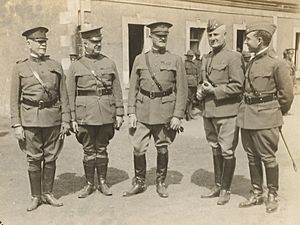
Pershing allowed American soldiers to be under foreign command for the first time. In June, British General Sir Henry Rawlinson suggested that American troops join Australian forces in the Battle of Hamel. This would give Americans experience and strengthen the Australian units. Major General George Bell Jr. chose American companies from the 33rd Division.
The day before the attack, Pershing learned of the plan. He ordered six American companies to withdraw. Most of the American troops left, which reduced the size of the Allied force. There was a last-minute request to remove all American troops. But General John Monash protested. He chose July 4 for the attack to honor the U.S. troops. The four American companies that stayed gained valuable experience. Pershing then gave clear orders that U.S. troops would not be used this way again.
African-American Units
Pershing followed the racial policies of President Woodrow Wilson. These policies supported "separate but equal" treatment. African-American "Buffalo Soldiers" units were not allowed to fight with the AEF. However, experienced non-commissioned officers were sent to other segregated Black units for combat. The American Buffalo Soldiers of the 92nd and 93rd Infantry Divisions were the first American soldiers to fight in France in 1918. But they fought under French command. Most of these units continued to fight under French command for the rest of the war.
Full American Participation
Organization
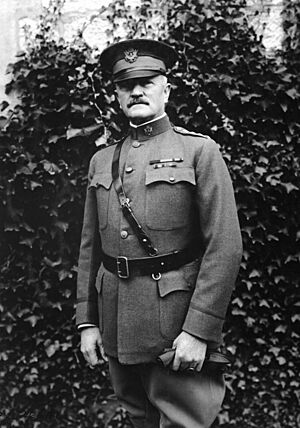
In March 1918, General Pétain told Pershing that he had few reserves left to stop the German Spring Offensive. Pershing offered all available American divisions to Pétain. This message was repeated to General Foch. Most of these divisions were sent south to help French divisions.
By early 1918, entire American divisions were fighting on the front lines with French troops. Pershing wanted the AEF to fight as American units. But the 27th and 30th Divisions were loaned to the British Fourth Army during the difficult spring of 1918. They fought with the British until the end of the war.
In May 1918, Pershing was unhappy with the Air Service of the American Expeditionary Force. He felt their planning was poor. He appointed his old West Point classmate, Major General Mason Patrick, as the new Chief of Air Service. Patrick made many changes, bringing in experienced officers and improving communication.
In October 1918, Pershing saw the need for a special Military Police Corps. The first U.S. Army MP School was set up in Autun, France. Because of this, he is seen as the founder of the U.S. MPs.
Due to the effects of trench foot on soldiers' feet, Pershing oversaw the creation of an improved combat boot in January 1918. This boot became known as the "Pershing Boot."
Combat
American forces first saw major action in the summer of 1918. Eight large American divisions, along with 24 French ones, fought in the Second Battle of the Marne. This Allied victory, along with the British victory at Amiens, was a turning point in World War I.
In August 1918, the U.S. First Army was formed. It was first under Pershing's direct command. Later, Lieutenant General Hunter Liggett took command when the U.S. Second Army was created. After a quick victory at Saint-Mihiel, the AEF had to move. They launched a major attack in difficult terrain at Meuse-Argonne. This offensive involved many German divisions.
The offensive was marked by a failure of Pershing's tactics. His reliance on large infantry attacks with little artillery support led to high casualties. This was even though the AEF faced weaker German troops. Pershing was later forced to reorganize the AEF and step down as commander of the First Army.
When he arrived in Europe, Pershing had criticized the slow trench warfare. He believed American soldiers' rifle skills would help them avoid costly fights. British and French commanders, and some Americans, thought this was unrealistic. Even German generals like Erich Ludendorff dismissed Pershing's efforts. The American casualties in the Argonne were high.
Some writers believe Pershing's frustration led to two incidents. First, he ordered the U.S. First Army to recapture Sedan. This caused confusion and put American troops in danger. General Liggett had to fix the situation. Second, Pershing sent a letter demanding that Germany not be given an armistice. He wanted the Allies to push for an unconditional surrender. Many later felt Pershing was right, but at the time, this was a political mistake. Pershing apologized for it.
At the time of the Armistice with Germany, another Franco-American attack was planned. Pershing claimed that the American breakthrough in the Argonne led to Germany accepting the armistice. However, other factors like civil unrest in Germany and Allied victories also played a big role.
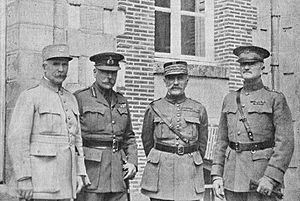
American successes were largely credited to Pershing. He became the most famous American leader of the war. He controversially ordered his troops to keep fighting before the armistice took effect. This caused 3,500 American casualties on the war's last day.
In 1918, Pershing also got sick during the 1918 flu pandemic, but he recovered. He rode his horse, Kidron, in the Paris victory parade in 1919.
Later Career
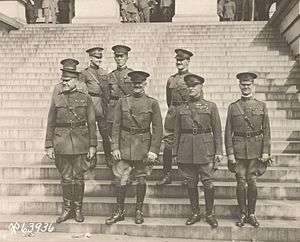
In September 1919, the U.S. Congress honored Pershing for his service in World War I. They allowed the President to promote him to General of the Armies of the United States. This was the highest rank possible for any U.S. military member, created just for him.
In 1976, Congress promoted George Washington to this rank after his death. This made Washington the highest-ranking U.S. Army officer ever. Pershing was allowed to design his own rank symbol. He chose to keep wearing four stars.
In 1919, Pershing created the Military Order of the World Wars. This was a group for officers who fought in World War I.
Some people wanted Pershing to run for president in 1920. He refused to campaign. He said he "wouldn't decline to serve" if the people wanted him. Pershing was a Republican. But many in his party thought he was too close to the policies of the Democratic Party's President Woodrow Wilson. The Republican nomination went to Senator Warren G. Harding.
In 1921, Pershing became Chief of Staff of the United States Army. He served for three years. He created the Pershing Map, a plan for a national network of military and civilian highways. The Interstate Highway System built in 1956 looks a lot like Pershing's map. On his 64th birthday, September 13, 1924, Pershing retired from active military service.
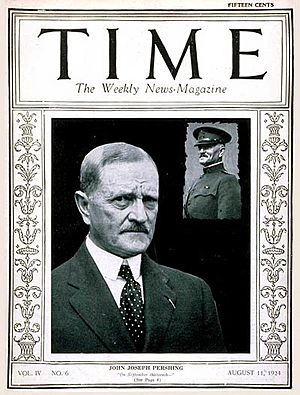
On November 1, 1921, Pershing was in Kansas City for the groundbreaking of the Liberty Memorial. Other important military leaders from Belgium, Britain, France, and Italy were also there. Vice President Calvin Coolidge was a main speaker.
In 1924, Pershing became a member of the Pennsylvania Society of the Sons of the American Revolution. He was also an honorary member of the Society of the Cincinnati.
During the 1930s, Pershing mostly lived a private life. He returned to public attention when he published his memoirs, My Experiences in the World War. This book won the 1932 Pulitzer Prize for history.
In 1940, before and after the Fall of France, Pershing strongly supported helping the United Kingdom during World War II. He publicly supported the "Destroyers for Bases Agreement". In this deal, the U.S. sold old warships to the UK for military bases.
In 1944, Congress created the five-star rank of General of the Army. Pershing was still considered the highest-ranking officer. His rank was General of the Armies. Secretary of War Henry L. Stimson said Pershing was senior to the new five-star generals.
In July 1944, General Charles de Gaulle, the leader of Free French forces, visited Pershing. Pershing asked about his old friend, Marshal Philippe Pétain, who had led France during part of World War II. De Gaulle replied that the Marshal was well.
Death
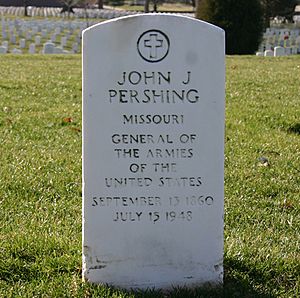
On July 15, 1948, Pershing died at age 87. He passed away from heart problems at Walter Reed General Hospital in Washington, D.C. This had been his home since 1944. He lay in state at the United States Capitol rotunda. After a state funeral, he was buried in Arlington National Cemetery. His grave is near the soldiers he commanded in Europe. This area is now called Pershing Hill. George C. Marshall, who was U.S. Secretary of State at the time, was in charge of the funeral plans.
Summary of Service
Dates of Rank
| Insignia | Rank | Component | Date |
|---|---|---|---|
| No Insignia | Cadet | United States Military Academy | July 1, 1882 |
| No Insignia in 1886 | Second Lieutenant | 6th Cavalry, Regular Army | July 1, 1886 |
| First Lieutenant | 10th Cavalry, Regular Army | October 20, 1892 | |
| Major | Chief Ordnance Officer, Volunteers | August 18, 1898 | |
| Major | Assistant Adjutant General, Volunteers | June 6, 1899 (Returned to permanent Regular Army rank of captain on July 1, 1901.) |
|
| Captain | Cavalry, Regular Army | February 2, 1901 | |
| Brigadier General | Regular Army | September 20, 1906 | |
| Major General | Regular Army | September 25, 1916 | |
| General | National Army | October 6, 1917 | |
| General of the Armies | Regular Army | September 3, 1919 | |
| General of the Armies | Retired List | September 13, 1924 |
Proposed Six-Star Insignia
| Insignia | Rank | Component | Notes |
|---|---|---|---|
| General of the Armies | Retired List | A six-star rank was suggested in December 1944. The law creating the five-star rank of General of the Army said Pershing was senior to World War II's five-star generals. It was thought a "General of the Armies" could wear six stars if he wanted. But Pershing died before Congress decided on this. |
Assignment History
- 1882: Cadet, United States Military Academy
- 1886: Troop L, Sixth Cavalry
- 1891: Professor of Tactics, University of Nebraska–Lincoln
- 1895: 1st Lieutenant, 10th Cavalry Regiment
- 1897: Instructor, United States Military Academy, West Point
- 1898: Major of Volunteer Forces, Cuban Campaign, Spanish–American War
- 1899: Officer-in-Charge, Office of Customs and Insular Affairs
- 1900: Adjutant General, Department of Mindanao and Jolo, Philippines
- 1901: Battalion Officer, 1st Cavalry and Intelligence Officer, 15th Cavalry (Philippines)
- 1902: Officer-in-Charge, Camp Vicars, Philippines
- 1904: Assistant Chief of Staff, Southwest Army Division, Oklahoma
- 1905: Military attaché, U.S. Embassy, Tokyo, Japan
- 1908: Military Advisor to American Embassy, France
- 1909: Commander of Fort McKinley, Manila, and governor of Moro Province
- 1914: Brigade Commander, 8th Army Brigade
- 1916: Commanding General, Mexican Punitive Expedition
- 1917: Commanding General for the formation of the National Army
- 1917: Commanding General, American Expeditionary Forces, Europe
- 1921: Chief of Staff of the United States Army
- 1924: Retired from active military service
- 1925: Chief Commissioner for the U.S. in a border dispute between Peru and Chile.
Honors and Awards
United States Decorations and Medals
| Army Distinguished Service Cross (1941) |
Army Distinguished Service Medal (1918) |
Silver Star (1932) |
| Indian Campaign Medal (1907) |
Spanish Campaign Medal (1905) (with silver citation star upgraded to Silver Star decoration in 1932) |
Army of Cuban Occupation Medal (1915) |
| Philippine Campaign Medal (1905) |
Mexican Service Medal (1917) |
World War I Victory Medal with 15 battle clasps (1919) |
| World War I Victory Medal with 15 battle clasps (1919) |
World War I Victory Medal with 15 battle clasps (1919) |
Army of Occupation of Germany Medal (1941) |
- Note: The dates are when the award was given, not when the action happened.
In 1932, Pershing's silver citation star was upgraded to the Silver Star. In 1941, he received the Army of Occupation of Germany Medal. This medal had Pershing's profile on it. He was one of only four U.S. military members to wear a medal with their own image.
International Awards
| Knight Grand Cross of the Order of the Bath (Britain) | Grand Cross of the Legion of Honor (France) | ||
| Military Medal (France) | WWI Croix de Guerre with bronze palm (France) |
Grand Cross of the Order of Leopold (Belgium) | WWI Croix de Guerre (Belgium) |
| Order Virtuti Militari (2nd class – Commander's Cross) (Poland) |
Order of the White Lion (1st Class with Swords) (Czechoslovakia) |
Czechoslovak War Cross 1918 | Grand Cordon of the Order of the Precious Jade (China) |
| Order of the Golden Grain (1st Class) (China) |
Order of the Redeemer (Grand Cross) (Greece) |
Grand Cross of the Military Order of Savoy (Italy) | Grand Cross of the Order of Saints Maurice and Lazarus (Italy) |
| Order of the Rising Sun (Grand Cordon) (Japan) |
Medaille Obilitch, Miloš Obilić medal (Montenegro) | Grand Cross of the Order of Prince Danilo I (Montenegro) | Medal of La Solidaridad (1st Class) (Panama) |
| Grand Cross of the Order of the Sun (Peru) | Order of Michael the Brave (1st Class) (Romania) |
Grand Cross of the Order of the Star of Karageorge with Swords (Serbia) | Grand Cordon of the Order of the Liberator (Venezuela) |
Civilian Awards
- Congressional Gold Medal
- Thanks of Congress
- Distinguished Service Medal, American Legion
- Special Medal of the Committee of the city of Buenos Aires
- Induction into the Nebraska Hall of Fame (1963)
- Honored with a U.S. postage stamp in 1961
Personal Life and Family
Pershing was a Freemason, a member of Lincoln Lodge No. 19, Lincoln, Nebraska.
Francis Pershing (Son)
Colonel Francis Warren Pershing (1909–1980) was Pershing's son. He served in World War II as an advisor to General George C. Marshall. After the war, he worked in finance and founded a stock brokerage firm. He had two sons who served in the Vietnam War. One of them, Richard W. Pershing, was killed in action in 1968.
Nita Patton (Fiancée)
In 1917, two years after his wife and daughters died, Pershing became engaged to Anne Wilson "Nita" Patton. She was the younger sister of his protégé, George S. Patton. Pershing met her when she visited her brother at Fort Bliss. Their engagement ended because Pershing was in France during World War I. Nita Patton never married. Pershing remained unmarried until he married Micheline Resco in 1946.
Legacy
- Since 1930, the Pershing Park Memorial Association in his hometown of Laclede, Missouri, has worked to preserve his memory.
- On November 17, 1961, the United States Postal Service released a postage stamp honoring Pershing.
- The 2nd Armored Brigade Combat Team, 1st Cavalry Division, is named in honor of Pershing. Its nickname is "Black Jack Brigade."
Images for kids
-
General John J. Pershing, Major General Beaumont B. Buck and Brigadier General Fred W. Sladen inspecting the Guard of Honor of the 3rd Battalion, 7th Infantry Regiment, 3rd Division, Vaucouleurs, France, 1918
-
Officers of the 89th Division being decorated by General John J. Pershing in Trier, Germany, April 1919
See Also
 In Spanish: John J. Pershing para niños
In Spanish: John J. Pershing para niños
- General Pershing WWI casualty list
- M26 Pershing Tank
- MGM-31 Pershing Missile
- Pershing (doughnut)



